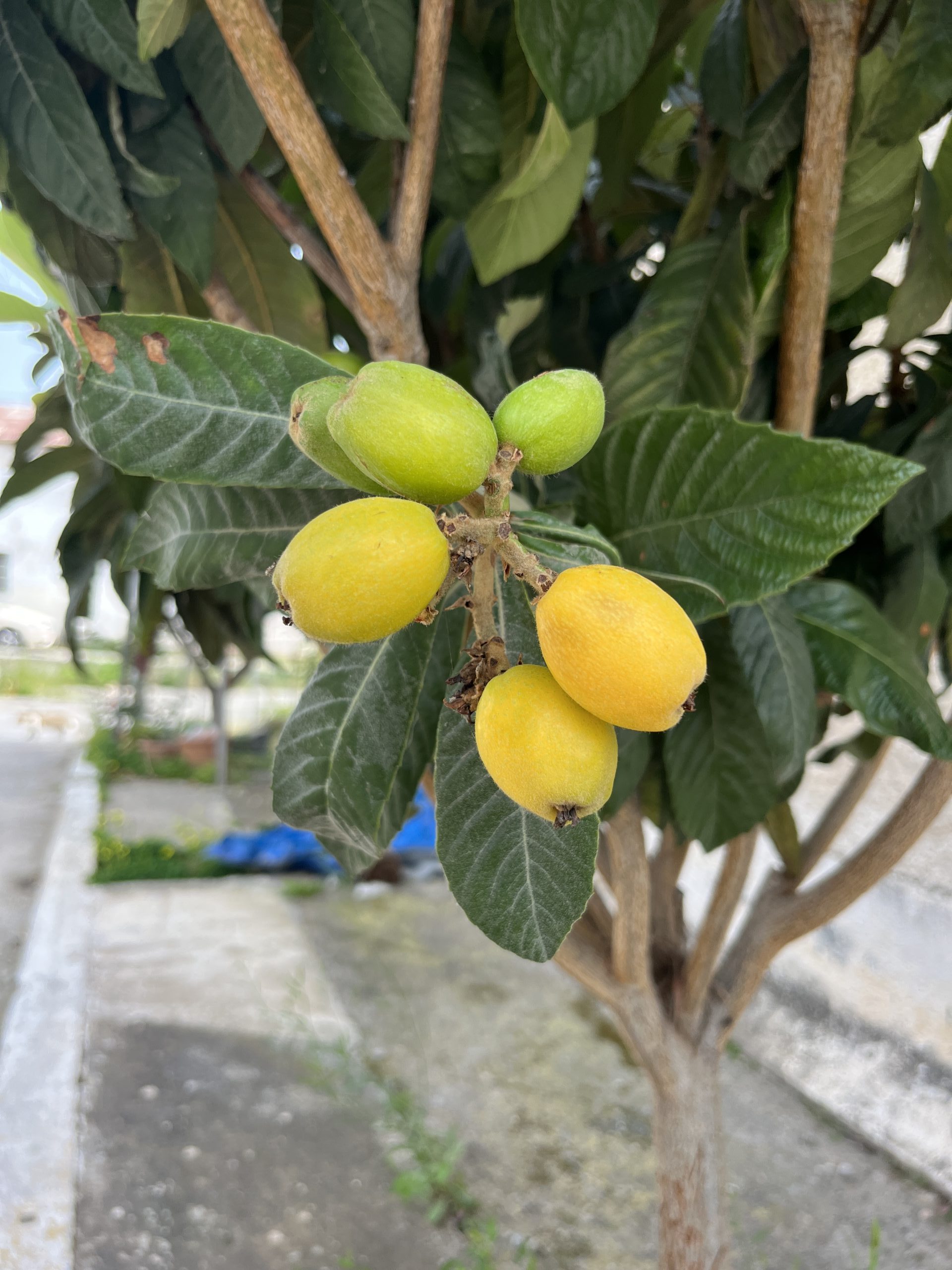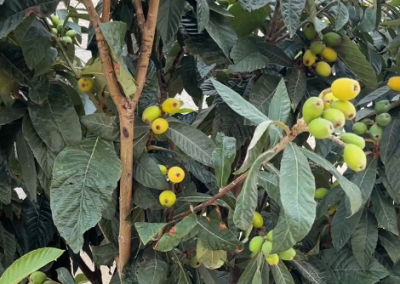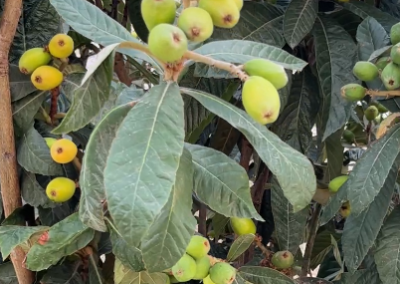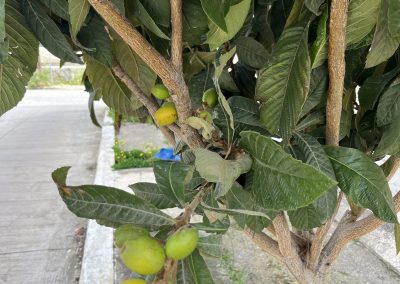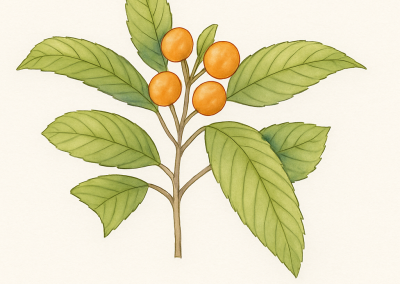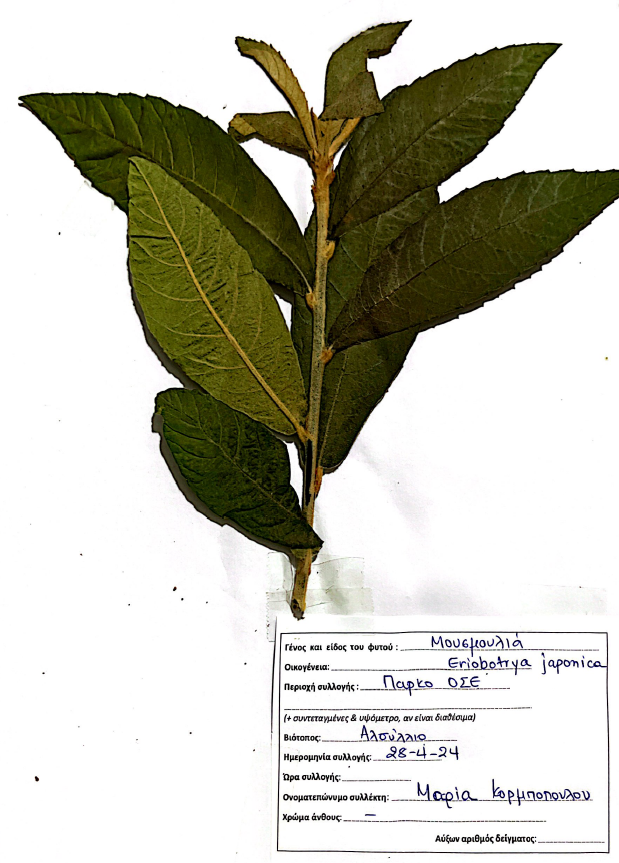Eriobotrya japonica
Scientific description
Scientific name: Eriobotrya japonica
Synonym: Rhaphiolepis bibas, loquat
Kingdom: Plantae
Syntax: Magnoliophyta
Taxonomy: Dicotyledons (Magnoliopsida)
Suborder: Rosidae
Order: Rosales
Family: Rosaceae
Genus: Eriobotrya L.
Species: Eriobotrya japonica
Origin:
One of the most ancient plants from Japan and China. Evergreen tree, 8 m tall with almost straight trunk. Leaves large and leathery, dark green above, slightly fuzzy green below, up to 25 cm long. Flowers white-yellow, almond-scented, forming dense clusters.
Propagation:
By sowing, cuttings, aerial propagation, or grafting on related trees like quince or mesquite.
Ecology:
Introduced to the Mediterranean late 17th century; cultivated systematically from mid-18th century. In Greece, introduced mid-19th century. Known locally as musmoulia, mespilea, nespolia, nospolia, despolia, mespilia.
Use:
Cultivated for delicious yellow fruit and as ornamental for rich foliage.
Notes:
Cases of toxicity after consumption of raw fruit have been reported.
Επιστημονική ονομασία: Eriobotrya japonica
Συνώνυμο: Rhaphiolepis bibas, Loquat
Βασίλειο: Φυτά (Plantae)
Συνομοταξία: Αγγειόσπερμα (Magnoliophyta)
Ομοταξία: Δικοτυλήδονα (Magnoliopsida)
Υφομοταξία: Ροδίδες (Rosidae)
Τάξη: Ροδώδη (Rosales)
Οικογένεια: Ροδοειδή (Rosaceae)
Γένος: Εριοβοτρύα L.
Είδος: Eriobotrya japonica
Καταγωγή:
Αρχαίο φυτό από Ιαπωνία και Κίνα. Αειθαλές δέντρο, ύψος 8 μ., κορμός ευθύγραμμος. Φύλλα μεγάλα, δερματώδη, σκούρα πράσινα πάνω, χνουδωτά κάτω, μήκος έως 25 cm. Άνθη λευκοκίτρινα με άρωμα πικραμύγδαλου, σε πυκνούς βότρυς.
Πολλαπλασιασμός:
Σπορά, παραφυάδες, εναέριες καταβολάδες, εμβολιασμός σε συγγενικά δέντρα.
Οικολογία:
Εισήχθη στη Μεσόγειο τέλη 17ου αιώνα, συστηματική καλλιέργεια από μέσα 18ου αιώνα. Στην Ελλάδα γύρω στα μέσα 19ου αιώνα. Ονόματα: μουσμουλιά, μεσπιλέα, νεσπολιά, νοσπολιά, δεσπολιά, μεσπιλιά.
Χρήση:
Καλλιεργείται για νόστιμους κίτρινους καρπούς και καλλωπιστικά για πλούσιο φύλλωμα.
Σημειώσεις:
Αναφέρονται περιπτώσεις τοξικότητας από κατανάλωση ωμών καρπών.
Nom scientifique : Eriobotrya japonica
Synonyme : Rhaphiolepis bibas, Loquat
Règne : Plantae
Syntaxe : Magnoliophyta
Taxonomie : Dicotylédones (Magnoliopsida)
Sous-ordre : Rosidae
Ordre : Rosales
Famille : Rosaceae
Genre : Eriobotrya L.
Espèce : Eriobotrya japonica
Origine :
Plante ancienne du Japon et de Chine. Arbre à feuilles persistantes, 8 m, tronc droit. Feuilles grandes, coriaces, vert dur dessus, légèrement duveteuses dessous, jusqu'à 25 cm. Fleurs blanc-jaune, parfum d’amande, en grappes denses.
Propagation :
Semis, bouturage, propagation aérienne, greffage sur cognassier ou mesquite.
Écologie :
Introduit en Méditerranée fin XVIIe siècle; culture systématique depuis milieu XVIIIe siècle. En Grèce, introduit milieu XIXe siècle. Noms locaux : musmoulia, mespilea, nespolia, nospolia, despolia, mespilia.
Utilisation :
Cultivé pour fruits jaunes délicieux et comme plante ornementale pour feuillage dense.
Remarques :
Cas de toxicité après consommation de fruits crus signalés.
Denumire științifică: Eriobotrya japonica
Sinonim: Rhaphiolepis bibas, loquat (moșmon japonez)
Regn: Plantae
Sintaxă: Magnoliophyta
Taxonomie: Dicotiledone (Magnoliopsida)
Subordin: Rosidae
Ordin: Rosales
Familie: Rosaceae
Gen: Eriobotrya L.
Specie: Eriobotrya japonica
Origine:
Una dintre cele mai vechi plante din Japonia și China. Arbore veșnic verde, 8 m, trunchi drept. Frunze mari, pieloase, verde închis sus, ușor pufoase jos, până la 25 cm. Flori alb-gălbui, miros migdale amare, grupuri dense.
Înmulțire:
Semințe, butași, înmulțire aeriană, altoire pe gutui sau mesquite.
Ecologie:
Introducere în Mediterana sfârșitul secolului XVII, cultivare sistematică de mijlocul secolului XVIII. În Grecia, mijlocul secolului XIX. Nume locale: musmoulia, mespilea, nespolia, nospolia, despolia, mespilia.
Utilizare:
Fructe galbene delicioase, ornamental pentru frunziș bogat.
Observații:
Cazuri de toxicitate după consumul de fructe crude raportate.
Creative writing inspired by Eriobotrya japonica
Eriobotrya japonica
Once, deep in the East, there was a small kingdom that lived in harmony with nature. The queen of this kingdom was the beautiful Japanese princess Naoko, known for her kindness and wisdom. Her people loved her, as she always had a way to heal the sick and bring peace to their hearts. Princess Naoko had a garden filled with rare trees and plants, but her favorite was a mysterious tree called Eriobotrya, or loquat tree.
According to an ancient legend, this tree was planted by the goddess of Spring, who gave it to mortals as a gift of love and protection. The fruits of the loquat tree were not only delicious, but they were said to have magical properties: they could heal coughs and respiratory illnesses, and anyone who ate them would feel joy and peace.
At some point, the kingdom was threatened by a fearsome dragon that lived in the clouds, bringing frost and destruction. The dragon envied the loquat tree, knowing that its flowers bloomed even when the land was frozen. So, he vowed to destroy it.
Naoko, seeing her kingdom in danger, prayed to the goddess of Spring for help. The goddess heard her prayers and descended to earth. She granted the loquat tree the power to withstand the dragon’s cold and bloom even in the harshest conditions.
When the dragon attacked with his frost, the loquat tree bloomed once again, filled with radiant golden fruits. The dragon, blinded by the light of the fruits, fled and never dared to return. The kingdom was saved, and the loquat tree became a symbol of resilience and hope.
Since then, every spring, when the first blossoms of the loquat tree appear, the people celebrate the memory of Princess Naoko and the tree's victory against the darkness.


